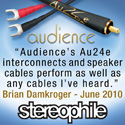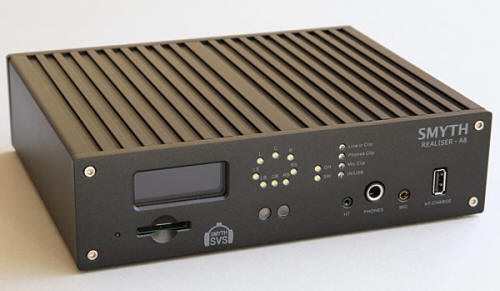|
|
You are reading the older HTML site
Positive Feedback ISSUE 63
smyth research Realiser A8 as reviewed by John Acton
My therapist would say I'm conflicted. For the past few years, I've vacillated between speaker-based and headphone-based listening. Since the birth of the hobby, the majority of audiophiles have listened to music through loudspeakers, and for good reason; with normal stereophonic (i.e. non-binaural) recordings, a properly dialed-in speaker-based system comes closest to reproducing a musical event, especially in terms of spatial realism and bass impact. Of course, the most elevated levels of speaker-based performance require an oftentimes exorbitant expenditure on loudspeakers, electronics, and ancillaries, as well as significant investments in a suitable room, treatment of that room's acoustics and meticulous speaker placement. When considerations of near-field vs. far-field listening, dynamic range capabilities and bass extension requirements are taken into account, it becomes easy to understand how much skill, not to mention luck, is required to achieve exceptional results. With the recent proliferation of cutting-edge headphones and headphone amplifiers, audiophiles have a legitimate alternative to speaker-based listening. Headphone listening possesses several key virtues. Via headphones, one can listen to music when he or she wants, and for as long and loudly as he or she wants, without fear of disturbing other family members, roommates, or neighbors. Headphones do not require dedicated rooms, acoustic treatments or adherence to rigorous placement guidelines in order to perform at their best. And, with the inherent low levels of coloration and high levels of resolution evinced by the top-tier headphone offerings, extraordinary performance can be obtained at a fraction of the cost of a commensurate speaker-based system. Lastly, those listeners with space constraints may simply have no alternative to headphones, as no matter how creative they are, speakers simply won't fit. With all those advantages, why haven't headphones forced speakers into an early retirement? For starters, unlike speakers, headphones are intrinsically incapable of portraying a realistic soundstage with performers occupying space in front of the listener. Soundstage depth and other imaging illusions are likewise not realistically conveyed. Secondly, headphones do not possess the ability to pressurize an entire room with deep bass like a good full-range speaker-based system. For many listeners, the lack of spatial verisimilitude and tactile bass reproduction override the positives of neutrality and resolution, relegating headphones to the category of "necessary evil;" one to be considered only when they've exhausted all avenues of listening via speakers. But what if one could replicate the experience of listening to music over loudspeakers, only through headphones? Impossible? Stephen and Mike Smyth of Smyth Research would have us believe otherwise. Inventor of the Digital Theater System (DTS) coding algorithm employed as the standard for cinema surround audio playback, Stephen partnered with Mike to co-found Smyth Research LLC in 2004 for exploring, as they state on Smyth Research's web site, the virtual sound reconstruction of real soundfields. Along the way, the Smyths enlisted the support of fellow DTS alums Steve Cheung and Lorr Kramer, as well as Takeo Asano. The Smyths' extensive research culminated in the creation of Smyth Virtual Surround (SVS), which was designed to replicate, via headphones, the experience of listening to loudspeakers in an actual space. The SVS process can emulate as many as eight channels and can duplicate exactly not only the sound of the speakers, but also their placement relative to the listener, as well as the sonic signature of the associated electronics and acoustic environment.
Smyth Research's first production offering is the Realiser A8, a bundled component system for measuring a source system and environment, performing the necessary DSP convolution calculations for emulating that captured system and environment, and outputting the treated signal to headphones. The main component in the Smyth Realiser package is the A8 itself. An unprepossessing black box measuring 8.6" wide by 7.9" tall by 2.3" deep and weighing approximately 4lbs, the A8 contains the SVS processing and user-control circuitry, as well as an on-board amplifier for dynamic headphones. The front-panel contains a small, multi-line display screen for communicating status to the user, lights to indicate which channels are in use, lights to indicate clipping conditions for the microphones, source inputs and headphone outputs, a 1/4" headphone jack, SD memory card reader slot and a USB charger for the supplied head tracker accessory. The rear panel is even busier than the front, containing RCA connections for eight input channels as well as eight output channels, HDMI inputs and outputs, RCA outputs for an external headphone amplifier and tactile bass seat shakers, a Toslink digital output and a 9v DC input for the power supply. The overall build quality of the A8 is very good and commensurate with its price, but audiophiles may turn up their noses at the utilitarian rubber footing provided by Smyth Research for easy stacking of multiple Realisers and the non-gold-plated RCA connections. My A8 review sample came with an unregulated wall-wart power supply, but Smyth Research now includes a sturdier power supply with detachable power cord for easier tailoring to international users' varying voltage requirements.
Included with the Smyth Realiser are a bevy of accessories. The supplied remote control provides access to every function necessary for operating the Realiser, but one must be cautioned that the Realiser can only be operated via its remote; without it, the A8 is largely reduced to a very large, very expensive paperweight. Smyth Research also includes two tiny, high-quality microphones for measuring the sound of the system and room to be emulated, as well as the user's headphones. Several foam inserts of varying size are provided for optimizing the microphones' in-ear placement. A two-piece head-tracking system, comprising a small satellite unit for attaching to one's headphones and a larger base unit for attaching to the front wall or screen facing the listener, is included for ensuring that the emulated image remains stable regardless of the listener's head rotation/positioning. A cable extension is also provided, which can be used to extend the range of either the microphones or base head-tracker unit. Lastly, Smyth Research can optionally include a STAX SRS-2170 headphone package, consisting of the SRM-252S driver unit / amplifier and SR-207 electrostatic earspeakers. The 104-page (!) instruction manual is not included in hard-copy format, but is available for download from Smyth Research's web site. Smyth Research warrants the Realiser A8 for a period of two years. I researched the Realiser A8 extensively prior to contacting Lorr Kramer at Smyth Research regarding review opportunities, and in the course of doing so, I noted that a significant majority of users posting on online forums were employing the A8 for multi-channel theatrical listening exclusively, with many two-channel users preferring standard, non-SVS-processed music playback over their headphones. Completely acknowledging that I would be squandering some of the Realiser's capabilities, I endeavored to focus my evaluation of the A8 and its SVS processing primarily on two-channel emulation. There was also a logistical hurdle to be overcome; I no longer possessed a high-end speaker-based audio system, which posed the obvious problem of not being able to secure a superior emulation. However, in researching online, I identified a Smyth Research dealer a mere five-hours' drive from me: Glenn Poor's Audio Video in Champaign, Illinois. Glenn Poor's owner Geoff Poor and sales manager David White were amenable to allowing me access to their facilities and guiding me through SVS emulation of their reference cinema and two-channel rooms. Over the course of two hours, David White and I were able to successfully capture and certify both systems. We spent the majority of that time fastidiously configuring everything prior to emulation and certifying the results after; the actual measurement process itself took no longer than 10 minutes in each room. So, how does the Realiser work? There is a wealth of detailed documentation available on the Smyth Research web site, but presented in non-technical terms, the SVS process accounts for the fact that each person's physiognomy is unique, from the shape and size of one's ears, to the shape and size of one's head and upper torso, to placement of one's ears on his or her head. These subtle physical variegations result in each person localizing sound sources in space and discerning the tonality of those sound sources differently. Previous attempts to recreate virtual out-of-head imaging via headphones have not been entirely convincing due to the employment of generic "dummy heads" for measurement purposes. As sensitive and finely-tuned as the human hearing interface is, personalized calibration is needed. Additionally, previous virtualizers have relied upon generic fabricated acoustical environments, rather than specific systems in actual rooms. The Smyth Realiser requires each user to measure a specific system and environment themselves to acquire virtual results indistinguishable from the source. The SVS measurement procedure is relatively simple, and while the first couple emulations take longer as one meticulously follows the very detailed, specific instructions provided by Smyth Research, invariably things go much faster as he or she becomes familiar with the process. The first calibration captures the sound of the room and system, the results of which Smyth Research refers to as a personalized room impulse response (PRIR). The user sits in the system's primary sweet spot, inserts microphones into his or her ears and remains still while the Realiser generates a number of frequency sweeps through the loudspeakers, which the microphones then record. Throughout this process, the user is instructed verbally to look center, then at the left and right loudspeakers. The second calibration, referred to by Smyth Research as the headphone equalization (HPEQ), is subsequently performed, whereby the user puts on his or her headphones over the in-ear microphones while the Realiser again generates a series of frequency sweeps. This measurement linearizes the headphones' response and corrects for interactions between the headphone earcups and the user's individual ear pinna shape. Having completed several SVS emulations, I feel the most critical (and difficult) step is placing the microphones optimally in one's ears. This is where having two mirrors to confirm their placement and/or having an assistant to do the same is invaluable. In addition to those at Glenn Poor's Audio Video, I captured several other systems, mostly assembled by myself at home, so that I could adequately confirm the calibration process as well as compare the accuracy of emulation results across different systems and rooms. I even followed Lorr Kramer's instructions in the manual for creating a virtual five-channel surround setup from just two speakers (hint: it involves a lot of rotating in one's chair), which turned out to be easier than I was led to believe from reading the manual, although the end results were not as convincing as those achieved via emulation of an expertly set up true five-channel installation on account of my not taking the time to optimally position the front speakers for surround. During the review period, I evaluated the Realiser A8 within the context of my reference system, which comprises the Schiit Lyr headphone amplifier with the Sennheiser HD 800 and AKG K702 headphones. My source was the Simaudio MOON CD5.3 CD player. Cabling included Hero AG and Timbre interconnects from Kimber Kable and the Big Twist interconnect from Tempo Audio, along with Audience powerChord 'e' power cords. The Audience aR2p-TO provided power conditioning with the Wireworld Matrix 2 power bar handling power distribution duties. The Solid Steel 8.2 Audio Table supported the entire system.
After all the time and effort invested, how did the Realiser perform? In a word, brilliantly. Arthur C. Clarke once stated that any sufficiently advanced technology is indistinguishable from magic. I was reminded of this quote often over the subsequent weeks as I listened to my music played back via the Realiser A8 and its SVS processing. It was a truly ineffable experience listening to Glenn Poor's reference two-channel system over a pair of headphones. The big thing was the imaging and soundstaging. St. Vincent's most recent album, Strange Mercy (CAD 3123CD) is fantastic musically, but its complex, multi-tracked mix does not lend itself well to headphone listening, as the multitude of instruments can quickly coagulate into an inarticulate jumble in one's head. Listening to Strange Mercy over the Realiser was revelatory, with the instruments now positioned across the room from me and separated appropriately from one another on a broad and deep stage, with excellent cohesion and layering. Annie Clark's vocals were fleshed out and dimensional, floating in front of the accompanying instrumentation, which represented a diametric contrast to the claustrophobic impression I normally experience over headphones, with her vocal vying for space in and amongst the cacophony of everything else happening. The head-tracker accessories (the satellite unit placed on the top band of my headphones, the base unit across the room) ensured that the image remained stationary and rock-solid no matter how rapidly I turned my head to the left or right, just as if the presentation was actually being generated out in front of me. Tonality, too, was unerringly captured, as was the harmonic texture of vocals and instruments. The accuracy of the replication was simply uncanny. Experimenting in my own home with a more modest set-up (Rotel electronics and Energy loudspeakers, all at least 12 years old), I could readily discern the Realiser-captured differences when I swapped out the solid-state Rotel amplification for a tube-based Jolida integrated. The real treat, however, was listening to my favorite recordings via the emulated Glenn Poor's reference two-channel system. Comprising Wilson Audio Sasha W/P loudspeakers, Balanced Audio Technology REX preamplifier, reference BAT monoblocks and Kubala-Sosna cabling in a treated room, the resultant sound I achieved exceeded that of even the finest and most expensive systems I've been able to assemble in my history as an audiophile. Muddy Waters' Folk Singer CD (Chess CHD-12027) has been a long-time reference for me, and listening to it over the Realiser via the Glenn Poor's two-channel reference-room emulation, I was astounded at the sheer timbral honesty and palpability that imbued Waters' vocal. And if I ever tire of that system, rather than spending many thousands of dollars assembling another rig, I can simply emulate other friends' and/or dealers' systems that I covet. The possibilities are nearly endless. What about downsides? Being able to capture and replicate multi-thousand-dollar systems and listen to them anywhere privately is all well and good, but there has to a catch, doesn't there? Actually, yes. The reproduction of truly full-range deep bass is accompanied by a visceral, tactile physicality and room pressurization that no headphone-based system can duplicate. And while the Smyth Research Realiser can work wonders, this is one miracle it can't perform. Through the Realiser and my headphones, I can hear the kick drums, electric bass and deep synthesizer notes occurring out in the room, but I don't feel them on my skin like I did at Glenn Poor's. Smyth Research is fully cognizant of this limitation inherent in any headphone-based solution, and to ameliorate its effects, they've endowed the Realiser with outputs for tactile bass seat shakers or subwoofers. I did not have an opportunity to try either option, but users have reported via head-fi.org that excellent, if not perfect, results can be achieved. A quick note regarding headphones and ancillaries. Smyth Research has designed the Realiser to be compatible with any headphone, and its HPEQ calibration goes a long way to reverse-equalizing out any tonal or spatial anomalies that might detract from the captured PRIR response. In the course of my evaluations, I utilized the AKG K702 and Sennheiser HD 800 dynamic headphones, driven by the A8's internal amplifier as well as by the Schiit Lyr hybrid headphone amplifier, and compared them to the STAX SRS-2170 electrostatic headphone and amplifier combo that Smyth Research optionally bundles with the Realiser. Frankly, I was surprised by the results. While in the strictest of headphone terms, the HD 800, especially when driven by the Schiit Lyr, handily surpassed the entry-level STAX offerings, the SRS-2170 pulled ahead in more accurately emulating the source system, both spatially and tonally, with soundstage cues more apparent and timbral hues more fleshed out. The differences weren't night-and-day, but they were clearly audible. I posit that the greater speed and transparency of the STAX combo helped to remove one more veil between myself and Glenn Poor's two-channel system and room. Likewise, while I achieved excellent results using Kimber Kable Timbre interconnects between my CD player and the Realiser A8, and from the A8 to the Schiit Lyr or STAX SRM-252S amplifiers, the performance improved significantly when I substituted either the Kimber Hero AG or Tempo Electronic Big Twist interconnects for the Timbres, which in no uncertain terms made it apparent that there are upgrade opportunities to be had in optimizing a Realiser-based system. While my focus in reviewing the Smyth Research Realiser A8 was unabashedly on its two-channel emulation capabilities, I would be remiss if I didn't at least touch upon its multi-channel capabilities. Utilizing a friend's borrowed Oppo BDP-93 universal player connected to the Realiser via its analog inputs, I was impressed by the surround effects and resulting immersion I experienced watching the Tron Legacy DVD. It was disconcerting (in a good way) to hear sounds to the front and rear of me over headphones, when I knew there to be no speakers in the room with me. The ultimate goal of the SVS process is to faithfully duplicate a speaker-based system and room for listening over headphones. But, Smyth Research have incorporated a number of features for users to customize and personalize their emulations. The A8 provides facilities to precisely adjust tone and virtual proximity of the speaker positions relative to the listener, as well as reverberation decay for rendering a drier, more anechoic virtual acoustic than what was present in the source environment originally captured. The Realiser also offers the user comprehensive bass-management options, as well as a volume limiter and accompanying sound-pressure reporting. I was twelve years old in 1982 when my dad bought me my first stereo as a Christmas present, a JCPenney modular system replete with rim-drive turntable and 8-track player. From those humble beginnings through the present day, I've been an avid audio enthusiast, and over the years, I've witnessed numerous advances in audio technology, a few truly revolutionary, most merely evolutionary. In all my experiences as an audiophile, I've never encountered as significant an advance in audio reproduction as Smyth Research's Realiser A8 and its SVS processing. Possessing the ability to realistically recreate over headphones any two-channel or multi-channel system and its acoustic environs represents the holy grail for financially-challenged or space-encumbered audiophiles. The ability to "collect" a library of multiple systems is just the proverbial icing on the cake. When I asked Lorr Kramer why the principals at Smyth Research aren't all millionaires yet as a result of their SVS invention, he explained that people can't seem to believe in the effects of SVS without experiencing them firsthand. Well, here's my testimonial as proof—I was so amazed by the Realiser's abilities that I purchased the review sample. I now have the best sound I've ever experienced in my listening room, and I've resolved my conflicted nature regarding headphones vs. speakers. Now I can have both. Postscript: Glenn Poor's Audio Video Glenn Poor Sr. and his son, Glenn Poor Jr., founded Glenn Poor's TV and Radio in 1949 in support of the burgeoning U.S. television market. Glenn Poor's focused specifically on the television and music playback markets through the fifties and sixties, expanding their footprint in the seventies to incorporate a projection screen and pre-Betamax video player, resulting in one of the Midwest's first home theater installations. In the mid-seventies, Glenn Poor's son, Geoff, opened two Glenn Poor's Audio Video stores in the Illinois towns of Normal and Champaign. Today, Geoff continues to own and manage the Champaign storefront, continuing a 60-year tradition of quality products and top-notch customer service. When I entered Glenn Poor's Audio Video to take my Smyth Research SVS measurements of their two-channel and multi-channel reference systems, I was greeted warmly by Geoff Poor and sales manager David White. Touring Glenn Poor's showrooms, I was impressed by the number of high-end manufacturers represented, as well as the number of models on display. Speakers from Wilson Audio, Focal, Genesis Technologies, Harbeth, Accapella and Dynaudio were partnered with electronics from Bel Canto, Cambridge Audio, Esoteric, Balanced Audio Technology, Rega and Jeff Rowland Design Group, to name a few. In addition to the current-production gear offered for sale, Geoff Poor also maintains and displays his collection of vintage gear, including electronics from Tandberg, Studer and Nakamichi. Seeing Poor's "shrine" venerating the golden age of high-end audio brought me back to my youth, reading about these very models in Stereo Review and High Fidelity magazines while I sat in my high school's library during study hall. Glenn Poor's 7.1 multi-channel reference room employs loudspeakers from Professional Home Cinema, electronics from Balanced Audio Technology and video projection courtesy of Sim2, all ensconced in an acoustically-superb and comfortable theater. The resultant audio / visual experience while viewing a Peter Gabriel concert was immersive and visceral. Glenn Poor's reference two-channel room showcases Wilson Audio loudspeakers and BAT / Esoteric electronics, with Kubala Sosna cabling throughout. Listening to my own CDs over the Wilson Audio Sasha W/P speakers driven by BAT amplification in-person at Glenn Poor's and later at home via the Realiser, my previous reserved respect for Wilson's offerings blossomed into something more akin to love. The Sasha takes the previous Watt / Puppy-series strengths of insight, detail retrieval and dynamic bombast, and couples them with newfound improvements in cohesion, midrange warmth and overall musicality. As a result of the Sashas' expert positioning and setup by Glenn Poor's, midrange purity and bass extension were outstanding, with no bloat or overhang. Image focus was exceptional, and if the sense of ultimate depth was slightly foreshortened due to the Sashas' relative proximity to the wall behind them, they compensated for this ably with a seamless spread of images across the soundstage, from the far left of the stage, through the center, and over to the far right. Rarely have I heard such a well-laid-out and realistic recreation of images occurring in space. While the overall acoustic was a touch more reverberant than I would ordinarily prefer, Glenn Poor's did an outstanding job at eradicating any slap-back echo or comb-filter effects with finely-tuned placement and toe-in of the Sasha W/P speakers. Glenn Poor's was the first retailer to partner with Smyth Research for the purposes of making the Realiser A8 and SVS processing available to customers. Glenn Poor's charges a reasonable fee of $200 per room to take SVS measurements of their systems, and this fee is waived for one room if the customer purchases his or her Realiser from them. John Acton
Smyth Realiser A8
Smyth Research LLC
Glenn Poor's Audio Video
|












